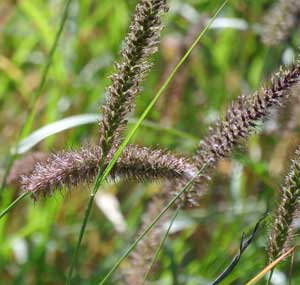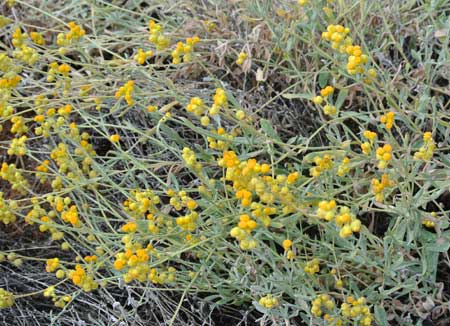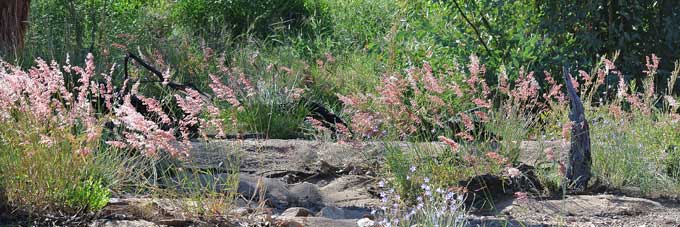By ERWIN CHLANDA
Is buffel the botanical cane toad, only worse? That’s the question PETER LATZ (pictured) is raising. He is Central Australia’s most prominent botanist, Hermannsburg born, fluent in the Arrernte language and widely published. He is the owner of a 20 acre rural block with some 120 native plant species and no buffel – after “2.5 man years over 15 years” of hard work controlling what South Australia has recently declared a weed. He started studying buffel 30 years ago. It’s a troubling account of short-sightedness and government incompetence. This is his story.
The cane toad is an ugly, poisonous pest. Cane toads have now grown longer legs so they invade new territory more quickly – as buffel has manipulated its genes to take over the country quickly.
Yet the Chinese, the curlews and the crows love cane toads. It’s an easy animal to catch and eat. I love eating their legs as the French love frogs’ legs. Cooking destroys their poison. The Chinese breed them to eat – you can eat all of the animal after cooking it. Curlews just eat their tongues which kills them eventually. Crows turn them over to eat them from the bottom up, avoiding the poison in their backs. So the hated cane toads are edible – it just goes to show: Nothing is all bad.
However, I drove along the Stuart Highway the other day, 10km north of Alice, keeping my eye open for any native grasses. I saw only three individual natives, and five million buffel.
It is now dominating the region. When I was a child in Hermannburg we already had a little buffel in the Finke river, a plant a third the size of present day buffel. It had come in Afghan camel saddles. It was not intrusive, not a problem.
Later CSRIO personnel were paid to travel the world to look for superior grasses to replace our “inferior” native grasses. Seeds from Africa, India and other countries were brought back, including five strains of buffel.
In 1970 a big area on the AZRI block – [where the Kilgariff suburb is now under construction] was planted with those seeds, in neat little rows, names proudly displayed. Buffel was the only useful grass that took off, alongside grasses unpalatable to cattle.
 Buffel (at right) is unique. It has very exchangeable genes. A different strain hybridised to form two new strains, and they took off like the cane toad.
Buffel (at right) is unique. It has very exchangeable genes. A different strain hybridised to form two new strains, and they took off like the cane toad.
Why did Alice Springs end up being the major town in Central Australia? It could have been Barrow Creek or Charlotte Waters, between Finke and New Crown, on the Overland Telegraph Line. The reason was the rich and varied soils around the Alice township.
This allowed stockmen, miners and so on to stay in town, having a beer, while their horses, donkeys and camels had something to eat. It allowed the Telegraph Station to run cattle, sheep and goats.
In the big drought of 1960s the surrounds of Alice Springs were totally eaten bare. Horses were feeding at the base of the cliff of Mt Gillen, the only place that had grass.
Buffel, with its new genetic setup, had no competition. Buffel requires fertile soils, it is phosphorus hungry. Most soils here are low on phosphorous.
Hopefully buffel will be restricted to only our most fertile soils, and not invade the two thirds of Central Australia with red earth and sands which are low on phosphorous.
An exception in sandy country is under desert oaks which bring up nutrients from deep down under the sand. A quarter of our sandy areas have desert oaks.
The pastoral industry likes buffel although the cattle don’t love it. In its younger days Central Australia was considered to be the best fattening country in good seasons. Cattle could recover and put on weight in a good season, on very nutritious sweet native grasses.
With the mixture between natives and buffel cattle do extremely well, but what makes them fat are the natives. In dry times cattle can fall back on buffel which shoots quickly after rain.
Unfortunately, cattle quickly exterminate the natives, and the stations will end up with a monoculture of one grass – buffel. Cattle prefer natives, they will eat them first, allowing buffel to take over.
There is toxin in buffel which causes “big head” – tumours – in horses. It will kill ponies if they have nothing but buffel to eat.
The biggest problem is that monocultures are very dangerous. Biodiversity is extremely important. The worst grassy weeds are wheat, barley, sugar cane and corn. They have taken over our best land. We have to breed new strains of wheat all the time that are rust resistant.
In a monoculture, fungi and insect pests take over and have a glorious time. In Queensland, where buffel has been around for a long time, there are now diseases in buffel because the soils are running out of phosphorus.
Farmers are topdressing with superphosphate. The cows have eaten out everything else, and buffel is the only thing left.
There is a much worse scenario in the future: in some rangelands in the US palatable grasses are gone and introduced grasses which cattle don’t eat have taken over.
It’s already happening. Ranches are closing down. Wildfires are burning away the shrubs.
In Central Australia we already have 10 unpalatable grasses infesting better soils. If buffel goes, we can end up in the same situation as parts of the US. Having widely displaced native grasses, we may need to look after buffel to save our cattle industry.
All this could spell the end of the cattle industry in Central Australia. “Top feed” – mulga – is safe. Cattle can survive on mulga, but they can’t breed and fatten on it.
The Central Australian desert is a tough organism which may have a Joker up its sleeve – we hope.
I’ve studied buffel in Simpsons Gap since 1971, and there is a glimmer of hope. The CSRIO in the ’60s set up an experimental plot. I recorded buffel on one of the 25 plots.
The plant died out after 30 years. We know now it can live for 30 years. The good news is that long established buffel is losing its vigour. Ten years ago we thought it would take over all richer soils.
 In the national parks, without cattle there to eat the more palatable natives, some are starting to fight back, especially the perennial daisy (pictured at left), with its attractive yellow flowers. Cattle eat it out of existence.
In the national parks, without cattle there to eat the more palatable natives, some are starting to fight back, especially the perennial daisy (pictured at left), with its attractive yellow flowers. Cattle eat it out of existence.
We can’t expect total recovery from buffel in the National Parks, but there may not be a total takeover by it.
Some 20 years ago Ken Johnson re-introduced bilbies to Simpsons Gap. To survive they need two plants to feed on, bush onion, which they dig up and eat, and annual grasses with lots of seed. Both are extinct in this study area, swamped out by couch and buffel. Good-bye bilbies.
So, buffel is worse than canetoads which have not caused the extinction of a single species or plant.
Drive towards Glen Helen and where the road crosses the Hugh River, turn right and follow the river to Hugh Gorge.
Mixed in with buffel and couch is an introduced pink grass (Red Natalgrass, pictured at bottom. There is buffel behind it). It is poisonous, nothing can eat it. The nasties are already well established here.
Our national parks are in big trouble. We now have three times as much grass fuel to burn away our shrubs. We have not found a good method for preventing fires devastating our parks.
[The most beautiful areas in the parks, the gorges, gaps and waterholes which are the backbone of our tourist industry, are also the areas with the best soils which buffel has invaded, displacing natives. Tourists are not coming here to see an ocean of buffel. NT Parks Minister Bess Price has washed her hands of the parks management fiasco, saying buffel is not a weed.]
We need to select areas within our parks for keeping alive native plants, as a seed source for the future. It’s too late for anything else. Besides, if you control buffel the risk is other weeds will come in.
Cane toads get all the attention, although they have not caused any extinctions at all. Why has money spent on them not been used for proper conservation? I guess, it’s because plants are not cuddly little creatures.
To be fair, buffel isn’t all bad: it is holding our soils together, reducing erosion, and putting carbon into the soil in areas that were formerly bare.
For dust control projects, natives take a bit longer to establish. It’s the old story: short time gain, long time pain. There are no free lunches in nature conservation.

